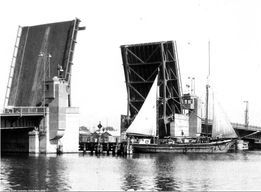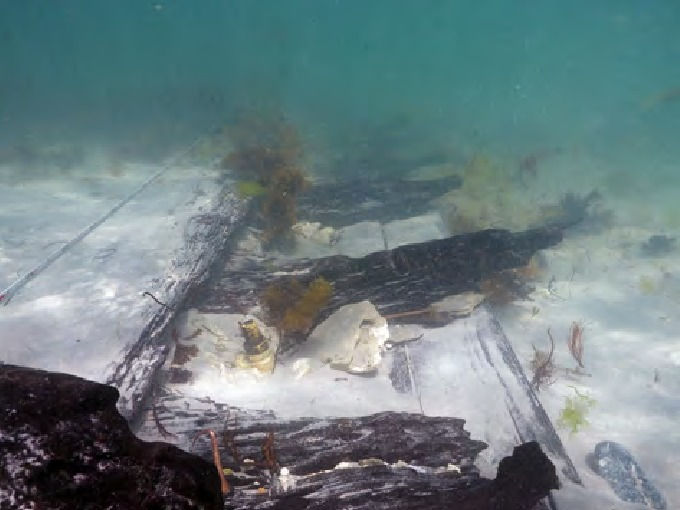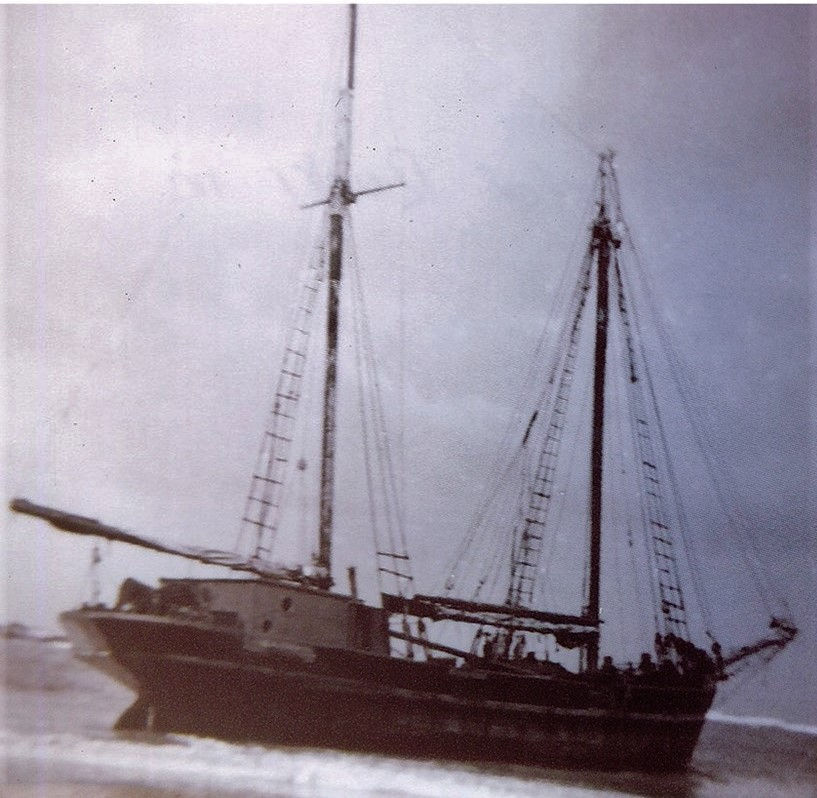The Hawthorn 'wreck' site in Bucks Bay
- Steve Reynolds
- Jun 25, 2023
- 7 min read
Member Greg Were posed a question on our Facebook page back in February: -
“Amongst other ships, my great-great-grandfather was skipper of the ketch the Hawthorn and the Steamship Ellen. I wondered if anyone knew whether either of these shipwrecks were ever visible at low tide - Ellen (Cape Jervis, Morgans Beach) and Hawthorn (Carpenter Rocks SE).
Kind Regards, Greg”

The Hawthorn 'wreck' site in Bucks Bay
(Gifford Chapman Collection)
I could only tell Greg at the time that the boiler from the Ellen was visible at low tide at Morgans Beach, or in the shallows. David Cowan added, “The Ellen's boiler is visible most of the time because it is located within the intertidal zone - what remains of the rest of the wreck is broken up and laying on the seabed”.
Greg followed this up in March: -
“Hi there, Does anyone know where I might find an accurate account of the sinking of the Hawthorn near Carpenter Rocks in the South East in 1949? It was a wooden ketch built in Franklin, Tasmania, probably made of Huon Pine. I am told it is visible at Carpenter Rocks on the beach near the car park but all images I have seen illustrate a steel hulled boat. So looking for a more recent image of the wreck and any info of how it got into trouble.
Kind Regards, Greg”
Chris Frizell sent in this photo of the Hawthorn passing through the Birkenhead Bridge: -

The Hawthorn passing through the Birkenhead Bridge
(Courtesy of Chris Frizell)
“A typical wooden Tasmania Ketch,” he added.” Most of them were built from blue gum and Huon pine.”
He then sent in this photo of the Hawthorn “just after going ashore”: -

The Hawthorn “just after going ashore”
(Courtesy of Chris Frizell)
By this time, Greg said that it was around 1910 when his great-great-grandfather skippered the Hawthorn.
I, myself, did not know about the Hawthorn at this stage and did not get too involved in the conversation. That all changed, however, when Greg and I met up and Greg asked me whether the wreck of the Hawthorn was visible at low tide. I didn’t know anything at all about the Hawthorn, but suggested that it was unlikely, otherwise I would’ve heard more about it.
We immediately looked for the Hawthorn in “South Australian Shipwrecks – A Data Base 1802-1989” by Peter Christopher (SUHR) but found that it was not listed. I told Greg that I knew that the Hawthorn was listed in “Ketches of South Australia” by Ronald Parsons, and I would check it out back at home. I later told Greg that the book stated that the Hawthorn had simply been broken up.
By this time, Chris had sent in these details of the Hawthorn, including the dimensions: - “67 feet x 19.2 feet x 7 feet, built Huon River 1875. Like most of the early ketches she would probably have been “trunnel” fastened. When she went ashore she had a large Kelvin 4 cylinder engine, the bore and stroke was 7.5 inches x 10 inches so it would have been a fair lump of metal. …… The register was closed 29/12/1961 with the comment “vessel broken up”. It is possibly that parts of her were salvaged and removed.”
Those details are matched in “Ketches of South Australia” by Ronald Parsons. That motor is described as a 46bhp auxiliary engine in the book. According to insurance registers, the motor had been installed by 1919. That fact was, however, not placed on official records until 1927.
The Hawthorn is described as a “wooden, two-masted ketch, ON57562, 53 tons”. When the motor was added to official records in 1927, however, the tonnage was given as 58 gross tons, 47 net tons.
The Hawthorn is further described as having a single deck with a round stern. Its “Register closed in 1961 when advice received it had been broken up”.
I did some further research on the topic back at home. I would Google something like “shipwreck of ketch hawthorn at carpenter rocks”. My search directed me to pages such as one titled Wreck of the Hawthorn, Carpenter Rocks SA, sank 1949. That page features this photo: -

The photo was captioned “Shipwreck of ketch Hawthorn at Carpenter Rocks”. I immediately told Greg, “Yes, I've seen images of the Hawthorn at Carpenter Rocks before.” Further searching, however, resulted in the discovery of this photo: -

Ketch Hawthorn wreck site (courtesy of the Government of South Australia)
I posted these two images on Facebook, asking, “So has the Hawthorn wreck at Carpenter Rocks gone from this to this?”: -


It was about this time that I told Greg that I was “Not sure those surface images resemble this UW wreck at all”.
I was soon advised on Facebook that “the top photo is Pisces Star and the bottom (photo) is Hawthorn”. I responded by saying that my suspicions had now been confirmed. (It seems that the Pisces Star went aground here on its maiden voyage from WA.)
Greg’s response to the photos was, “Thanks Steve - I found both of these too, and the first one doesn’t seem timber, or a ketch, and the second seems fully submerged, hence my query - but I had read somewhere someone saying it was visible and original photos of the wreck in 1949 show it clearly wrecked on the beach. I’m going down that way sometime and hopefully find some locals who know the story, thanks, Greg.”
It turns out that, in August 2020, Rick Bullers had written a paper titled “Timber Selection in Tasmanian Colonial Shipbuilding: A Preliminary Predictive Model”. According to the paper, “During a survey in 2014, a total of seven timber samples were collected from Hawthorn (Fig. 5)*. Two frames and one outer plank were made from Tasmanian blue gum, a ceiling was made from jarrah (E. marginata), another outer plank was made from western red cedar (Thuja plicata), a treenail was made from red ironbark (E. sideroxylon) and the centreboard was made from river red gum (E. camaldulensis) (Petracarro 2014)” (Petraccaro, D. 2014. Hawthorn fieldwork results. Report prepared for Heritage South Australia, Department for Environment and Water, Adelaide.)
* (The underwater photo of the Hawthorn wreck site is Fig.5 in the paper.)
Further, “Hawthorn was said to be built of “gum, stringy bark and pine… and… fitted with… [a] Huon pine cabin” (Tasmanian Tribune 1875). Elsewhere, construction timbers were described as “gum, with Huon pine topsides” and a stateroom in which the “fittings are made from the real Huon pine, a very pretty wood when polished” (The Mercury 1875). These appear to be Mason’s timbers of choice, as his next vessel, the ketch Trucanini, also built at Franklin, was described similarly as being “built of gum with pine topsides and decks” (The Mercury 1876). The wood samples generally confirm the historical description, with framing and at least some planking made from locally sourced Tasmanian blue gum. The other components sampled were made from trees that are not endemic to Tasmania. Hawthorn was sold to South Australian interests in 1876 and spent the next 73 years working the gulf trade and latterly as a fishing vessel. It is likely that the non-Tasmanian timbers were the result of maintenance or alterations during its long working life.”
Fate intervened when the following post coincidentally appeared on Heritage South Australia's Facebook page: -
“This week’s #shipwreckfriday post spotlights the two-masted, 54-ton wooden auxiliary ketch Hawthorn, built in 1875 at Franklin on Tasmania's Huon River for John Philp. The vessel measured 67 ft (20.4 m) long, 19 ft (5.8 m) in beam and 7 ft (2.1 m) deep, and was constructed from gum, stringybark and Huon pine. Hawthorn was the first vessel designed and built by Joseph Mann of Peppermint Bay. The vessel had numerous owners during its long life, most of it spent trading between Port Adelaide and Kangaroo Island or the west coast of South Australia. Its sundry cargoes included flux, gypsum, general cargo, crayfish and sometimes evens tourists, transporting them to and from the Queenscliffe Hotel at Kingscote or taking them sailing and fishing in the bay.
“Hawthorn had a long and interesting life, not without its share of tragedy and misfortune. It transported the skeletal remains of a 6.5-m whale that washed up on Queenscliffe Beach to Port Adelaide for the Adelaide Museum. Its cook, Antoneo Masquero, disappeared mysteriously after rowing a fellow crewman ashore at Queenscliffe, his abandoned dinghy being found the following morning some 6.5 km away. Not long after, while Hawthorn was moored at Port Adelaide, its master, Capt. William Jacobs, committed suicide when he learned that the woman he loved had married another man. Hawthorn was also very nearly lost at sea or ashore on at least three previous occasions. Its ultimate demise came in February 1949, while in the ownership of cray fisher Fred Von Stanke of Carpenter Rocks. Hawthorn was moored in Bucks Bay when a violent storm blew up, causing the ketch to drag its anchor and run aground. As there was no boat in the Bay large enough to pull Hawthorn off and refloat it, the ketch was stripped of anything of value and dismantled by its owners.
This image featured in the Facebook post: -

Images: Hawthorn (top left) loading wool at Bay of Shoals (K.I.) in 1936; (top right) under the Birkenhead Bridge at Port Adelaide in 1946; (bottom right) aground at Bucks Bay in 1949; (bottom left) abandoned and partially dismantled at Bucks Bay in 1951 (Gifford Chapman Collection).
I asked the question, "Is the Hawthorn wreck listed as such anywhere at all?" on Facebook. Philippe Kermeen responded "In Port MacDonnell Maritime Museum it is listed there and Mount Gambier Museum and Beachport Museum. Carpenter Rocks town has info on it as well."
In summary, Hawthorn was moored in Bucks Bay in February 1949 when a violent storm blew up, causing the ketch to drag its anchor and run aground. As there was no boat in the Bay large enough to pull Hawthorn off and refloat it, the ketch was stripped of anything of value and dismantled by its owners.
I have now separated some of the photos that appeared together on Heritage South Australia's Facebook page: -

The Hawthorn abandoned & partially dismantled at Bucks Bay in 1951
(Gifford Chapman Collection)

The Hawthorn loading wool at Bay of Shoals (K.I.) in 1936

The Hawthorn aground at Bucks Bay in 1949
These photos and the relevant details can be found on Instagram .




Comments